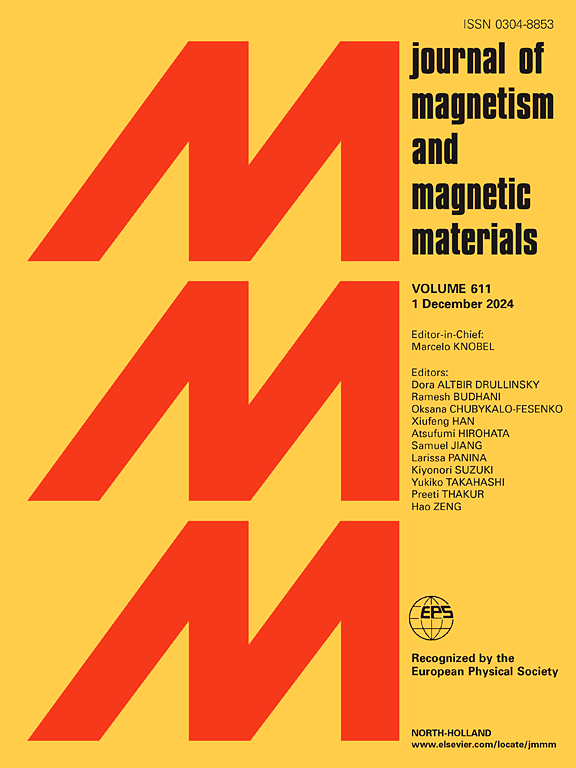Heusler Zr2RhIn合金体和(111)、(001)、(110)表面的磁性和电子性能
IF 2.5
3区 材料科学
Q3 MATERIALS SCIENCE, MULTIDISCIPLINARY
引用次数: 0
摘要
采用第一性原理计算方法(GGA-PBE)研究了Heusler合金Zr2RhIn的体和(111)、(110)、(001)表面的电子和磁性能。计算表明,化合物Zr2RhIn在平衡晶格常数为6.8±0.01 Å时表现出全自旋极化和半金属铁磁性。少数派通道的能隙和自旋翻转隙分别为0.47和0.11 eV。总磁矩为2±0.05µB,符合Slater-Pauling规则。对Zr2RhIn合金的(11 11)、(0 0 1)和(11 10)表面的电子、磁性和原子弛豫特性进行了研究。结果证实,半金属性质在Zr1-、Zr2-和in -端(11 11)表面得到保留,但在rh端(11 11)表面由于表面状态的原因消失,在(0 0 1)和(11 10)表面也同样消失。这些发现突出了半金属性对表面取向和终止的敏感性,使Zr2RhIn成为自旋电子器件的有希望的候选者。本文章由计算机程序翻译,如有差异,请以英文原文为准。
Magnetic and electronic properties of bulk and (111), (001), and (110) surfaces of the Heusler Zr2RhIn alloy
The electronic and magnetism properties of the bulk as well as (111), (110), and (001) surfaces of Heusler alloy Zr2RhIn have been studied by using first-principles calculations with (GGA-PBE) method. According to calculations, the compound Zr2RhIn exhibits full spin polarization and half-metallic ferromagnetic behavior at an equilibrium lattice constant of 6.8 ± 0.01 Å. The energy gap and spin flip gap in the minority channel are 0.47 and 0.11 eV, respectively. The total magnetic moment is 2 ± 0.05 µB which agrees with the Slater-Pauling rule. The electronic, magnetism properties and atomic relaxation were examined for the (1 1 1), (0 0 1), and (1 1 0) surfaces of the Zr2RhIn alloy. The results confirm that the half-metallic property was preserved at Zr1-, Zr2-, and In-terminations (1 1 1) surfaces, but disappeared at Rh-terminated (1 1 1) surface due to the surface states, likewise disappeared at (0 0 1) and (1 1 0) surfaces. These findings highlight the sensitivity of half-metallicity to surface orientation and termination, making Zr2RhIn a promising candidate for spintronic devices.
求助全文
通过发布文献求助,成功后即可免费获取论文全文。
去求助
来源期刊

Journal of Magnetism and Magnetic Materials
物理-材料科学:综合
CiteScore
5.30
自引率
11.10%
发文量
1149
审稿时长
59 days
期刊介绍:
The Journal of Magnetism and Magnetic Materials provides an important forum for the disclosure and discussion of original contributions covering the whole spectrum of topics, from basic magnetism to the technology and applications of magnetic materials. The journal encourages greater interaction between the basic and applied sub-disciplines of magnetism with comprehensive review articles, in addition to full-length contributions. In addition, other categories of contributions are welcome, including Critical Focused issues, Current Perspectives and Outreach to the General Public.
Main Categories:
Full-length articles:
Technically original research documents that report results of value to the communities that comprise the journal audience. The link between chemical, structural and microstructural properties on the one hand and magnetic properties on the other hand are encouraged.
In addition to general topics covering all areas of magnetism and magnetic materials, the full-length articles also include three sub-sections, focusing on Nanomagnetism, Spintronics and Applications.
The sub-section on Nanomagnetism contains articles on magnetic nanoparticles, nanowires, thin films, 2D materials and other nanoscale magnetic materials and their applications.
The sub-section on Spintronics contains articles on magnetoresistance, magnetoimpedance, magneto-optical phenomena, Micro-Electro-Mechanical Systems (MEMS), and other topics related to spin current control and magneto-transport phenomena. The sub-section on Applications display papers that focus on applications of magnetic materials. The applications need to show a connection to magnetism.
Review articles:
Review articles organize, clarify, and summarize existing major works in the areas covered by the Journal and provide comprehensive citations to the full spectrum of relevant literature.
 求助内容:
求助内容: 应助结果提醒方式:
应助结果提醒方式:


